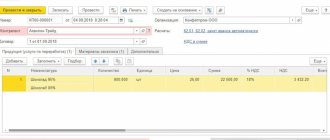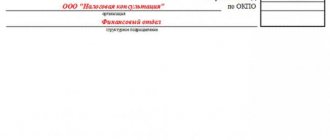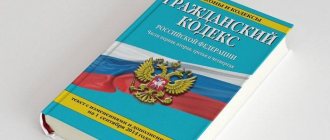Rules for drawing up a payslip
This document reflects the amount that the buyer agrees to pay by accepting the supplier's terms.
Today we will talk about the basics of primary documentation in accounting. It is the primary document that “triggers” the collection and change of information in accounting areas, i.e. change the status of accounting accounts. Let's find out a little more new things.
The defendant loses the opportunity to dispose of the property or funds of the credit institution. State authorities that carry out property registration are notified of the court decision. Article 80 of the Federal Law No. 229-FZ of October 2, 2007 stipulates the confiscation of the debtor’s property by the bailiff in order to carry out due collections.
These are funds that are sources of formation of enterprise assets (sources of financing). External sources of financing are Liabilities, and internal sources are Capital.
According to its structure, the OKPO classifier is divided into the following sections:
- The first section : combines important information about business entities, which include legal entities, their representative offices and branches, organizations without the status of a legal entity.
- Second section : contains general information about business entities - individual entrepreneurs.
important issues in the accounting policy or in the management order itself , namely:
- how documents are numbered;
- in what ways the possibility of corrections is allowed;
- How does storage work?
Expenditure - expenses of future periods in terms of fixed assets (for example, annual maintenance of equipment).
Using such comparison indicators, it is possible to compare labor productivity in different countries and determine where and how many times it is higher; compare prices for various goods, economic indicators of different enterprises, etc.
It must be remembered that when expanding the scope of economic activity, as well as when changing it, the relevant information should be submitted to the state statistics body, on the basis of which the organization will be assigned a new OKPO code.
UPD: what is this in accounting?
The Tax Service has long been considering the question of how to eliminate the primary documentation of any company, because sometimes documents duplicate each other in whole or in part. Not so long ago it was proposed to use the so-called UPD.
UPD is an abbreviation that can be deciphered as a universal transfer document. From the name of the document itself it immediately becomes clear that such a document is not intended for internal purposes, but to achieve certain external goals.
The appearance of such an accounting document is somewhat reminiscent of an invoice, and it was on its basis that the UPD was developed. For the first time, the UPD form itself was offered to business entities in 2013. True, it cannot be said that the UPD contains the details of only the invoice; it also contains certain details of the delivery note. In particular, the part that is used to draw up the declaration itself is taken from the invoice.
It should be said right away that the form is not mandatory for completion and use by firms. It is advisory in nature. Therefore, business representatives have the right to choose. Also, such a document cannot be used for all operations. And this became possible because since 2013, business entities have been allowed to use those reporting forms that are convenient for them, and not those that are clearly unified by the Federal Tax Service. The main thing is that such documents contain the information necessary for all users.
Basic accounting terms
Then what criteria should be used to select events for drawing up a primary document? Let's figure it out. To do this, we will rely on our knowledge.
PPP can be private (set for a certain group of goods) and general (set for the total product). In connection with PPP, such well-known concepts as the “barrel index” and the “Big Mac index” are known, which characterize simple ways of determining PPP relative to a single commodity. The indicator calculated in this way is called the growth (decrease) coefficient. It shows how many times the indicator of the current period is greater (less) than the indicator of the previous (base) period. Expressed in %, the relative indicator of dynamics is called the growth (decrease) rate.
If you mark PR in the document, in the documents it is “Accounting type NU” in the upper right corner, then the cost data for this operation will not be taken into account in tax accounting. Apparently, when processing payment orders from the bank, the accountant noted PR instead of NU, so the register for the declaration shows such data.
The second section of the OKPO block contains the OKPO encoding created using the ordinal coding method. However, in this section, the encoding already includes ten digital characters, nine of them are considered serial numbers, and the tenth, final character is a control number, also compiled using the Calculation Method.
For example, an institution conducts several types of activities - educational and medical. Two IFOs are being introduced (at the expense of educational activities and at the expense of medical ones). When entering source documents, the corresponding individual financial information is indicated. As a result, it is possible to generate reports (any kind, including regulated ones) both for the institution as a whole, and separately for each type of activity (IF).
Payments will be accepted through the divisions of Sberbank of Russia OJSC and the Federal State Unitary Enterprise Russian Post, as well as through the cash desks of client offices of INTER RAO - Oryol Energy Sales LLC.
For example, an institution conducts several types of activities - educational and medical. Two IFOs are being introduced (at the expense of educational activities and at the expense of medical ones). When entering source documents, the corresponding individual financial information is indicated. As a result, it is possible to generate reports (any kind, including regulated ones) both for the institution as a whole, and separately for each type of activity (IF).
Payments will be accepted through the divisions of Sberbank of Russia OJSC and the Federal State Unitary Enterprise Russian Post, as well as through the cash desks of client offices of INTER RAO - Oryol Energy Sales LLC.
Sick leave is a certificate of incapacity for work issued by a medical organization in the prescribed form.
Accounting for financiers, or Accounting without debits and credits
This document reflects the amount that the buyer agrees to pay by accepting the supplier's terms.
As you already know, the reason for drawing up the primary document is the events that happen in the enterprise. However, not all events need to be classified as those that require the execution of a primary document.
The arbitration court begins the process after receiving an application from the injured person. The rendered decision secures the claim and guarantees compliance with the material interests of the applicant (Article 90 of the Arbitration Procedure Code of the Russian Federation). Most often, property is seized to secure a claim for debts.
The balance sheet contains information about the financial position of the company as of a certain date. It consists of Assets, Liabilities and Capital. The balance sheet is usually drawn up as of a specific date. The first section of OKPO indicates the OKPO code itself, which was compiled by coding using the ordinal method. It includes strictly eight digital characters, seven of them contain information regarding a specific sequence number, and the last, eighth character is a check number.
In this case, the tax inspectorate does not have any complaints regarding the issue that the company, in the course of its work activities, issues different forms of “primary tax” to its clients.
The indicator indicated in the line is the sum of the balances on accounts 07 and 08. If the company owns assets that, due to certain circumstances, cannot be reflected in the other lines of section 1, then these assets should be taken into account in this line.
OPS are usually expressed in the form of coefficients or percentages, the sum of the coefficients should be 1, and the sum of the percentages should be 100, since the specific weights are reduced to a common basis.
You can find out the OKPO code of an organization from the financial and legal documents of this company. Tax reporting and accounting documentation must indicate the current OKPO number.
If the OKPO code is lost, you can always request it again from the state statistics agency (there is a fee for obtaining information). To obtain the code, you must provide the following documents to the statistical authorities:
- Information that the organization is registered with the Federal Tax Service at its location.
- Certificate of state registration.
- A copy of the extract from ERGUL.
- A copy of the company's charter, certified by a notary.
Then what criteria should be used to select events for drawing up a primary document? Let's figure it out. To do this, we will rely on our knowledge.
According to the theory of purchasing power parity, exchange rates should tend to equal purchasing power, because their different purchasing power encourages their movement to where they can buy more product. The implications of this theory are common in various studies of national income, living standards, and gross domestic product of states.
The indicator calculated in this way is called the growth (decrease) coefficient. It shows how many times the indicator of the current period is greater (less) than the indicator of the previous (base) period. Expressed in %, the relative indicator of dynamics is called the growth (decrease) rate.
For example, when an accountant enters the receipt of goods, works, services, then filling out the fields organization, counterparty, settlement document, agreement, warehouse, the accountant also indicates the type of tax accounting: it will be NU or PR.
Decoding in Spreadsheet Document 1C mp3
It is the summation of all the company's transactions over a certain period of time. That is, what transactions were carried out and how they affected the financial position of the company (that is, changes in its balance sheet). Accordingly, GTC and ODDS are compiled for a certain period (for example, for a year, month, etc.). Someone may have a significant debt on fines or taxes, as a result of which government authorities are forced to seize property. It is sold under certain circumstances. To avoid possible misunderstandings, you need to understand this issue in more detail. Need to know The client's debt to the bank is strictly controlled by the credit institution.
How then could the copier change the information so that it would be necessary to issue the primary document? To begin with, it could break down beyond repair, i.e.
Despite the fact that the goals of these accounting are different (tax reporting in the first case and competent business management in the second), the basic principles of accounting still converge.
In different situations, a universal document can not only act as a “primary” document, but also combine invoices and primary documentation.
Why was UPD invented?
One of the main problems in accounting is the abundance of documents. Papers of varying degrees of importance and necessity fill the accountant’s workspace. In order to lighten the workflow a little and reduce the amount of paper used, a universal document was created that contains several documents.
Let’s imagine that we apply the general tax regime and install equipment on the customer’s vehicles. You need to complete 4 documents:
- waybill for equipment + invoice for it;
- certificate for work performed + invoice for it.
The introduction of UPD into the document flow made it possible to replace 4 documents with one - the UPD itself.
IMPORTANT!
UPD combines the functions of a primary document (for example, a waybill, act, etc.) and an invoice.
Please note that the use of UPD is not an obligation, but a right of an economic entity. If you wish, you can print or send electronically two or four documents. But why?!
Features of accounting by centralized accounting departments
The form of a universal primary document should be developed exclusively for those business transactions for which the company has decided to use it. The main document on which to rely when drawing up a balance sheet is Order No. 66n of the Ministry of Finance. It is with the help of this document that you will be able to understand the procedure for entering data into the balance sheet, as well as the method of deciphering it.
Questions and answers are included in the IS “PARAGRAPH” unchanged in accordance with the original, which will allow you to refer to them when situations arise that require confirmation and justification of your position (when interacting with government agencies, among other things).
TD means temporary differences between accounting and tax accounting. Such differences arise when expenses are recognized in accounting in one period, and in tax accounting in another period. Therefore, the difference is temporary, which should eventually become zero.
How to become such a specialist?
To become an OPD, you or your company must register in the Roskomnadzor system. After which you can begin to perform your duties.
In order to get into the register of operators, you must act according to this plan:
- Log in to the Roskomnadzor website and fill out the form.
- Afterwards, select the name of the territorial body, the type of public document and enter information about the legal entity.
- The completed form is printed, then signed and sent by mail to the Roskomnadzor authority.
- Here, information about the organization is entered into the register of operators, who process them for 1-1.5 months. An extract from the register can be easily obtained in printed form or on the Roskomnadzor portal.
Read about how to register with Roskomnadzor as an OPD here.
How to register on the site as an OPD?
In order to register on the site as an OPD you need:
Submit a notification to Roskomnadzor. This can be done on the Internet or in the organization itself.- The application indicates the current location and the list of data that will be processed.
- Waiting for approval.
- Obtaining consent to conduct activities in just a few days. It will act as confirmation of the activities of the OPD.
How to make changes?
In order to make changes, you need:
- Submit an application to Roskomnadzor.
- It indicates which information is outdated and which is reliable.
- There is no need to wait for confirmation. You can continue to work further.
It is important to remember to make changes, as if this is not done on time, a fine will be imposed.
We talk about the rules for making changes to the OPD register here.
Report on the reflection of wages in regulated accounting by division
Another example of BP can be depreciation. The cost of a fixed asset in accounting and tax accounting at the time of receipt is the same, but the methods and rates of depreciation are most often different. The cost of the fixed asset will be expensed, both in accounting and tax accounting, but this will happen in different periods, which is why a temporary difference is formed.
Cash includes cash in current accounts with banks, cash on hand and demand deposits.
OKPO is often used by entrepreneurs as a requisite when filling out contracts and licensing documents, and also allows you to obtain information about a particular organization, which is an important point when checking information about the counterparty under the agreement.
Events after the balance sheet date include all events up to and including the date the financial statements are authorized for issue, even if they occur after the entity's earnings or other financial information have been published.
Rights and obligations
According to Federal Law No. 152, OPD has the following rights and obligations:
- Ensuring the secure processing of information means taking all technical and organizational measures that will help protect against accidental or unauthorized access. This may include changing, destroying, copying, blocking and distributing information, as well as carrying out other illegal actions with it.
- Data processing must be of a notification nature.
According to Article 2 of Federal Law No. 152, before processing information, he must notify the authority for the protection of the rights of subjects and the intention to process information. Roskomnadzor enters information about the operator into a special register. The information contained in the registry, with the exception of security information, is completely publicly available. - Upon receipt of data, he must obtain written permission to process it. An exception may be cases when data is provided to the operator on the basis of law. The subject can always revoke permission without giving reasons.
- He must provide the subject with information in order to protect personal data.
- He must destroy or block all information, as well as make changes about the provision of illegal information by the PD subject, confirming that the data is not presented in full, is out of date or is no longer reliable.
The rights of the OPD are as follows:
- Obtaining the subject's consent to the processing of personal data (Article 9 of Law No. 152-FZ).
- Confidential publication of documents and subsequent processing of information (Article 18.1 of Law No. 152-FZ).
- Publication of acts aimed at identifying violations of the legislation of the Russian Federation.
- Notification of Roskomnadzor about the start of work with PD (Article 22 of Law No. 152-FZ).
Old and new balance: similarities and differences
If you do not need to receive regulated reporting in the context of various sources of financing, then it makes sense to create only one individual financial institution.
Many current assets are used simultaneously when they are released into production (for example, raw materials). Current assets are one of two groups of assets of an organization (the second is non-current assets). Accordingly, one of the two sections of the Balance Sheet Asset is called “Current Assets”. Current assets are also called current assets.
Otherwise, materiality in the preparation of financial statements is determined by a combination of qualitative and quantitative factors.” Additional capital is one of the components of liabilities, i.e. the company’s sources of funds, included in the “Capital and Reserves” section of the Balance Sheet.
Receipts from ordinary activities can be called differently, including from sales of goods, work, services or commissions.
The notes provide descriptive explanations or disclosures of items provided in those reports and information about values that do not qualify for recognition in those reports.
For information on what to follow when drawing up such a document, read the article “What are the rules for drawing up expense reports?”
Due to the fact that these adjustments do not affect the reliability of the reports, there is no need to recalculate the existing indicators, so tax officials will not have any questions.
The entrepreneur does not report on it to the state. It is not regulated by law. But to effectively run a business you can’t do without it.
Due to different rules for recognizing income and expenses in accounting and tax accounting, accounting profit may differ from tax profit. In this case, the deemed tax on accounting profits will differ from the current tax on profits reflected in the income tax return. A business entity has the right to draw up interim balance sheets throughout the year. At the discretion of management, the accountant may prepare a balance sheet quarterly or semi-annually. The information contained in interim balance sheets can be used by management to analyze the current state of the company. There is no need to submit such reports to the Federal Tax Service.
Transition process
The step-by-step algorithm for switching to UPD is as follows.
Initially, you need to decide under what agreements the organization will issue UTD to its clients or, conversely, wants to receive such a document from counterparties. For your information, the tax authority is confident that UTD can be used under agreements:
- supplies (purchase and sale);
- donations;
- provision of any services;
- contract;
- instructions.
In addition, it is possible to use the assignment of rights of claim, storage, trust management, license agreement, etc., which is provided for in Appendix No. 2 of the Letter of the Federal Tax Service of the Russian Federation dated October 21, 2013.
It is possible to test the UPD exclusively on the delivery of goods, and for agreements for the provision of any services, use standard forms developed personally by the organization.
The UPD form must be approved. The form of a universal primary document should be developed exclusively for those business transactions for which the company has decided to use it.
The developed form can be approved by signing a separate order from management or in the accounting policy.
Accounting policies can be modified during a calendar year in exceptional situations. Formally, the UTD form developed by the tax service does not apply to them (according to Article 8 No. 402-FZ). But there is a small nuance here: the company only needs to edit the forms of primary documentation, which are indicated in the appendix to the accounting policy.
Due to the fact that these adjustments do not affect the reliability of the reports, there is no need to recalculate the existing indicators, so tax officials will not have any questions.
In addition, experts recommend making a reservation that the company has the right to use other forms of “primary” established by agreement with the client. For example, a TORG-12 consignment note or a universal agreement in which the parties decided to add other additional payments. In this case, the tax inspectorate does not have any complaints regarding the issue that the company, in the course of its work activities, issues different forms of “primary tax” to its clients.
In addition, it is recommended to record several important issues in the accounting policy or in the management order itself, namely:
- how documents are numbered;
- in what ways the possibility of corrections is allowed;
- How does storage work?
It will be most convenient not to mix the “primary” with invoices, but to store them separately. This way you can eliminate the possibility of confusion if you need to submit them to the tax authority.
It is necessary to appoint responsible employees who will subsequently be responsible for signing the universal form.
The UPD must be signed by those employees who are involved in preparing the invoice and primary documentation. The right to sign is recorded in the company’s documents: on the basis of a power of attorney or an order from management. Preliminary agreement with counterparties is required.
You should definitely agree on the transition to UPD with regular customers in order to eliminate the possible need to correct documentation in the future. This is due to the fact that many clients may prefer the first option (as before, receive two forms - an invoice and a work certificate).
If there is customer consent to use the universal form, there is a need to conclude an additional agreement under existing contracts.
It is imperative to discuss a number of conditions that are directly related to the issuance of this document.
- There is a possibility that a certain form of “primary” was initially approved in the agreement with the counterparty. If this was the case, then adjustments must be made to the terms of the agreement.
- If the company wants the counterparty to certify the universal form with a seal, it is necessary to indicate this in an additional agreement.
- A specific procedure for correcting the universal form must be discussed. In this situation, suppliers have every reason to comply with their conditions, as set out in their accounting policies. This is due to the fact that a situation may arise in the future in which clients will require suppliers to correct documentation in different ways.
The situation is that the tax authority has not yet developed certain rules that could interpret the nuances of the universal document.
Any errors in indicators that directly relate to the invoice must be corrected exclusively according to the rules approved by Decree of the Government of the Russian Federation of December 26, 2011 No. 1137.
It is necessary to prepare a short reminder for employees. This is due to the fact that at first, employees will definitely have many questions regarding the UPD, and there will most likely be shortcomings in the documentation itself.
The memo should contain information such as:
- instructions for filling out the UPD;
- what details need to be thoroughly checked if the universal document came from a direct supplier;
- put a stamp on the UPD or not;
- what options for correcting errors are provided in the universal document.
If counterparties are required to issue different forms of “primary”, then this is indicated in the memo first. You can specify a specific list of clients who need to issue a universal document, as well as when there is a need for an invoice and TORG-12.









